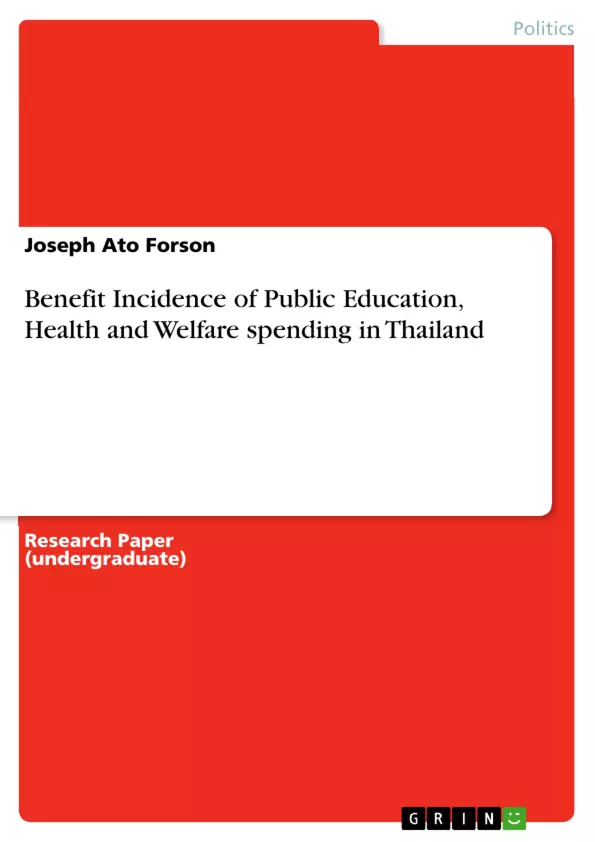In this paper, there is an attempt to compile evidence on the benefit incidence of public education and health spending in 2005 in Thailand. The 2005 data marks an improvement over Medhi Krongkaew’s 1979 analysis due to changes in the creation of the quintile income groups and marked improvement in the data collected on the whole. This paper is used to ascertain which income groups tend to benefit more from social spending. The paper also explores the relationship between benefit incidence on the one hand and indicators of access to education and health services and social outcomes on the other using simple measures of association. In addition, the paper explores the policy implications of these findings. In general, there is an attempt to enhance the position of the poor as the total (all) post-expenditure saw a major improvement in the Gini coefficient to record 0.2818 from 0.3056 or a rate of improvement of 2.38%. On the basis of these findings, it could be concluded that government’s interventions or subsidies on the two functional areas is pro-poor or progressive as it seeks to favor the poor. This will enhance the position of the poor as to accessing these two facilities in Thailand. We make a number of policy recommendations to enhance government’s efforts in eradicating poverty in the not distant future.
Inhaltsverzeichnis (Table of Contents)
- Abstract
- Acknowledgement
- 1. General Overview
- 2. Research Questions
- 2.1 Research Objectives
- 3. Methodology of Benefit Incidence Analysis
- 4. Empirical Evidence
- 4.1 Income Distribution by class and household characteristics
- 4.2 Distributional Effects of Public Spending by Functional Areas
- 4.3 Post-Expenditure income distribution
- 5. Policy Recommendation
- REFERENCE
- APPENDIX
Zielsetzung und Themenschwerpunkte (Objectives and Key Themes)
This paper analyzes the impact of government spending on public education, health, and social welfare in Thailand, particularly focusing on how these expenditures benefit different income groups. The paper aims to determine the effectiveness of government interventions in reaching and benefiting the poor population. The analysis utilizes the Benefit Incidence Analysis (BIA) tool, a method for measuring how government spending on social services is distributed across income groups. This investigation seeks to understand the relationship between benefit incidence and access to essential services, exploring how social spending impacts health and education outcomes.
- Benefit Incidence Analysis (BIA) and its application to public spending in Thailand
- Distributional impact of public education, health, and social welfare spending on different income groups
- Relationship between benefit incidence and access to essential services like education and healthcare
- Assessment of the effectiveness of government interventions in reaching and benefiting the poor
- Policy recommendations to enhance government efforts in poverty reduction
Zusammenfassung der Kapitel (Chapter Summaries)
The paper begins with an introduction that discusses the importance of government interventions to address poverty and ensure equitable access to basic services. It emphasizes the need for tools like Benefit Incidence Analysis to evaluate the effectiveness of government spending on social programs. Chapter 3 outlines the methodology used for analyzing the distribution of benefits from public spending.
Chapter 4 focuses on the empirical evidence, analyzing income distribution, the distributional effects of public spending in various sectors, and the post-expenditure income distribution. This chapter provides insights into how public spending influences the distribution of income and resources across different income groups. The paper concludes with a discussion of policy recommendations aimed at enhancing government efforts in poverty reduction.
Schlüsselwörter (Keywords)
This paper focuses on the key themes of public spending, benefit incidence analysis, poverty reduction, access to education and healthcare, and distributional effects of government interventions in Thailand.
- Citation du texte
- Joseph Ato Forson (Auteur), 2013, Benefit Incidence of Public Education, Health and Welfare spending in Thailand, Munich, GRIN Verlag, https://www.grin.com/document/213306



